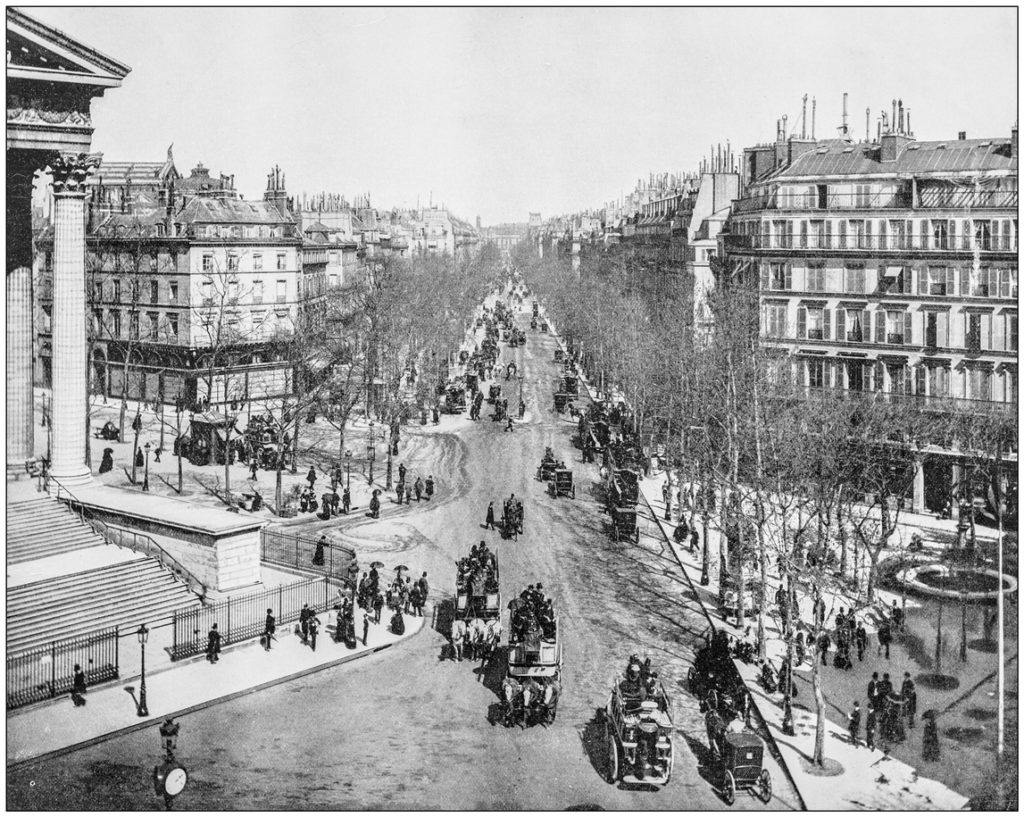Time to whip out your favorite macaron recipe (or do what I do and just buy some)—and some extra-strong coffee for mom—for a taste of Grand Paris! Let’s learn a bit about this famous city’s long history with an eye toward some lesser-known facts. Then, let’s get hands-on with a creative activity about Paris architecture that will be fun for everyone in the family!
Instructions:
- Turn on some French cafe music. You know, the accordion kind. Throw some croissants in the oven, and grab your berets. Then, after creating some Parisian atmosphere at your kitchen table, show your children where Paris is on a map or globe.
- Read through the lesson with your kids. Pause to look up additional pictures, videos, and facts about this amazing city. Follow the rabbit holes wherever they lead!
- Take time for the discussion questions. Lively conversation can be the best teacher.
- Have fun with the hands-on activity. Take pictures, but don’t take it too seriously! This will be the thing that cements this lesson in their minds.

A brief history of Paris, “The City of Light”
Read: Paris is the capital city of France. Its origins date back to the 3rd century BCE when the area was inhabited by a sub-tribe of Celts called the Parisii. The Celts were a collection of Indo-European tribes who shared a similar language and culture and inhabited northern and central Europe. Over the centuries, the Romans pushed the Celts out of present-day France, restricting their culture to Ireland and northwestern Britain. For several generations, this town founded in northern France by the Parisii was just a little fishing village.
In 52 BCE, the area was conquered by the Romans who called the city Lutetia. It was not an important city when occupied by Rome, but they improved it nonetheless, bringing the town its first roads, public baths, and amphitheater.
Paris became its official name in the fourth century, and the first king of the Franks, Clovis I, made the city his capital in the year 508.
Paris has been at the center (literally and figuratively) of European history and nearly all of its major events. There were at least seven major sieges of Paris from 845, by the Vikings, to 1870-71, by the Prussians. France as a whole has been invaded many more times than that, by the Huns, Romans, and Gauls in ancient times to Britain and Nazi Germany in the modern era, so Paris has seen its share of global culture come and go.

Learn More: Study prehistoric France. They have some of the oldest cave paintings in the world, 15,000-17,000 years old, at Lascaux, which include depictions of the amazing animals that lived there at the time.
Discuss: How do you think France’s invasion by so many different cultures from so many different parts of the world has contributed to their culture today? Do you think a society could benefit in any way from invasion by a different nation, or would all the results be negative? Did the Romans, for example, bring any improvements to Lutetia (Paris)? How do you think the citizens of the city felt when they learned invaders were coming? What might they have done to prepare? How would you feel if your city were invaded, and what would you do to prepare for it?
Read: Paris sits on an arc of the Seine River, stretching out on both banks, and includes two islands. Today, the city encompasses an oval of approximately 34 square miles; the Seine is crisscrossed by 37 bridges. Many of these bridges are tourist attractions themselves.
Several walls have been built over the years to defend the city against its frequent invaders—at least eight different walls to be exact—the most recent being the Theirs Wall built in 1846.
Learn More: Look up medieval wall and fortification building techniques. Also, check out the fierce siege machinery of the age that invading nations used to get past those walls!
Discuss: Building a wall around a whole city was a long and difficult process. Why was it so important for cities of that era to do so? What were the drawbacks to a walled city? (Hint: Crops and water sources were often outside the walls.) Why don’t most cities have walls around them now?
Read: As the city grew, it was much like any other medieval city with narrow winding streets and poor sanitation. A city redesign began under King Louis XIV, who forbade new streets to be less than 30 feet wide. The city’s remodel, with wide boulevards and channels that diverted traffic around the busy city center, was not completed until the mid-1850s.
Interestingly, the French Revolution played a major part in the design of the “new Paris.” Revolutionaries used the narrow streets to effectively thwart government agents and set up barricades. The new wide streets allowed large numbers of troops to move through the city quickly and were nearly impossible to barricade.
The redesigned, modern Paris also included many gardens, shops, and avenues for strolling, setting the stage for today’s street-life culture. For hundreds of years, Paris has been an epicenter of art, architecture, and fashion. The Gothic, Baroque, Classical, Romantic, and Impressionist styles all have roots in this city.
Learn More: Become an expert on medieval and Renaissance architecture—learn to spot the difference between Gothic and Baroque! Find out in which style you see pointed arches, domes, large frescoes, flying buttresses, rose windows, or gargoyles.
Explore: Look up pictures of famous Parisian landmarks and see if you can identify the architectural style. Try the cathedral of Notre-Dame, Les Invalides, the Temple du Marais, and Chartres Cathedral.

Fascinating Paris Facts and Events
- The Eiffel Tower was supposed to be temporary. Built for the 1889 World Fair, it was only meant to last for 20 years. At first, many people thought it was an eyesore, but, by the time it was supposed to come down, the city had fallen in love with its now iconic tower.
- Paris was the site of a duel . . . in hot air balloons. In 1808 duels were the popular way to settle arguments in Paris, so popular that it was said King Louis XIII issued over 8,000 pardons for murders associated with them! But ordinary duels were not enough for Monsieur de Grandpré and Monsieur de Pique. They decided it would be much more interesting to take their battle 2,000 feet in the air and shoot at each other’s hot air balloons. What was all the fuss about? To win the smile of a lady.
- The Louvre Museum used to be a palace, and it’s huge! This biggest museum in the world was originally a fortress, turned into a palace, turned into a museum. It would take you 100 days to see all the art in it if you looked at each piece for 30 seconds! Except for a brief tour to the US, the world-famous Mona Lisa has made the Louvre her permanent home. (Oh, except that time the Emperor Napoleon took it out to hang it in his private bedroom and when it was stolen for two years in 1911.)
- The French military still uses carrier pigeons. Kept close to Paris, these pigeons are the last pigeons in Europe to officially hold this job, which is just in case of extreme catastrophe. But don’t think of them as too old-fashioned! The French military was on the cutting edge as they were the first to have an official military dress code and coined the term “camouflage.”
Activity – Make a Model of a Paris Landmark

Materials:
- Images of your Paris landmark of choice. For more fun, have everyone pick a different one so that you have a whole mini-Paris when you’re done! Some good choices are:
- Notre-Dame,
- the Eiffel Tower,
- the Arc de Triomphe, or
- the Louvre.
- Any fun building materials to create your landmark. Get creative! Here are some ideas:
- Legos or other building bricks
- Play-doh or modeling clay
- Magnetic tiles
- Graham crackers and royal icing (for an edible landmark)
- Cardboard or thick poster board
- Foam or balsa wood
- Popsicle sticks
- Hot glue or school glue to hold it all together
- For the child who loves Minecraft, challenge them to build their model there!
- A protected surface to create your model—one that’s moveable if you want to store it.
Instructions: Get building! You can make this activity as quick and simple or detailed and involved as you like.
Study about the landmark’s history and architectural style while you’re building. What was it originally built for? Is it still used for that today? Has it been drastically changed since it was first built, or is it largely the same?
Add decorative touches like plastic toy animals for gargoyles or scrollwork made out of icing. Don’t forget to take pictures when you’re finished!
Written by Vida Mercer: Vida is a second-generation homeschooler, writer, writing coach, and curriculum developer. Born and raised in Southern Maryland, Vida met her husband, Jonathan, literally on horseback during a stint in North Texas. Now, they live in Northern California where they love to travel, day trip, and weekend with their two daughters. They, of course, incorporate their adventures into their homeschool lifestyle and wouldn’t have it any other way!
